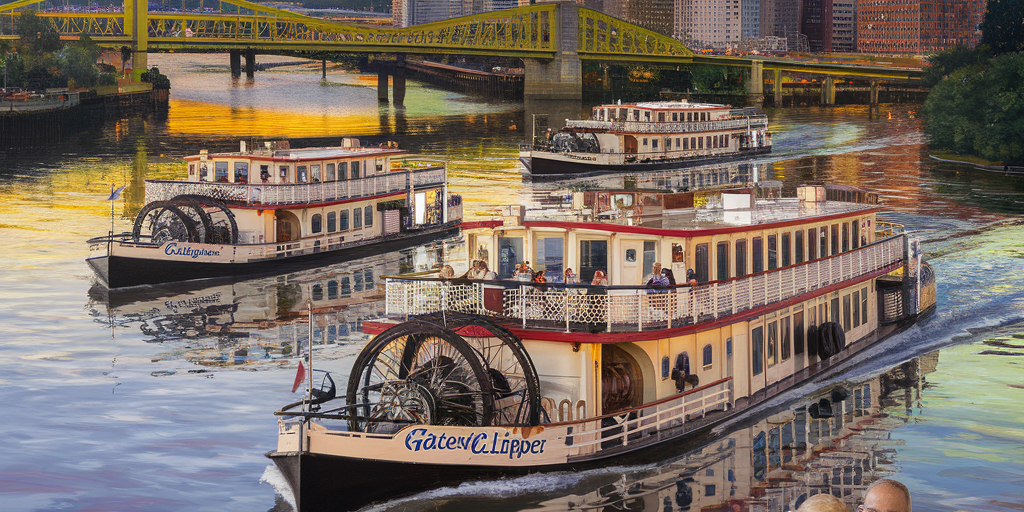Introduction: A Pittsburgh Icon on the Three Rivers
When people think of Pittsburgh’s rivers today, they picture the Gateway Clipper Fleet — a collection of elegant riverboats cruising the city’s iconic waterways. For more than 60 years, the Clipper has been more than just a sightseeing cruise — it’s a floating piece of Pittsburgh history, carrying generations of locals and visitors through the city’s industrial past and vibrant present.
This is the story of the Gateway Clipper Fleet, a symbol of Pittsburgh’s river heritage and a beloved tradition.
The Birth of the Gateway Clipper Fleet (1958)
The Gateway Clipper’s story begins in 1958, when John E. Connelly, a local entrepreneur, launched the original Gateway Clipper vessel. Inspired by Pittsburgh’s rich river history, Connelly wanted to revive riverboat cruising for entertainment, tourism, and civic pride.
The first boat, named the Gateway Clipper, offered sightseeing cruises that celebrated the city’s industrial might and natural beauty. The idea took off, and over the decades, the fleet grew.
Why “Gateway”?
Pittsburgh was historically known as the “Gateway to the West” — a major shipping and trade hub. The name was a tribute to that legacy.
Expansion and Growth: Becoming a Pittsburgh Institution
Throughout the 1960s and 1970s, the Gateway Clipper Fleet expanded as Pittsburgh transformed from a steel city to a service and tech hub. More boats were added, including:
- The Three Rivers Queen
- The Majestic
- The Princess
- The Empress
- The Countess
Each vessel offered dining cruises, sightseeing tours, school field trips, and wedding events, making the fleet a fixture on the city’s waterfront.
By the 1990s, the Clipper became one of the largest inland riverboat fleets in the United States.
The Experience: Cruising Pittsburgh’s Industrial and Natural Beauty
What made the Gateway Clipper special wasn’t just the boats — it was the view:
- Steel mills turned to skyscrapers along the Monongahela River.
- Historic bridges like the Smithfield Street Bridge and the Fort Pitt Bridge span overhead.
- Pittsburgh’s skyline transforms at sunset.
The cruises became a way to see Pittsburgh’s past and future side by side — from the days of barges and coal to gleaming office towers and stadiums.
Challenges and Adaptation: Weathering Pittsburgh’s Changes
Like the city itself, the Gateway Clipper faced challenges:
- The decline of the steel industry changed the scenery but also opened up the rivers for recreation.
- Weather, flooding, and changing tourism trends forced the company to adapt.
The Clipper survived because it continued evolving — adding themed cruises, concerts, and sports event shuttles for Pirates, Steelers, and Penguins games.
The Gateway Clipper Today: A Living Tradition
Today, the Gateway Clipper Fleet docks at Station Square and runs nearly year-round cruises — from elegant dinner cruises to kids’ pirate adventures.
It remains a Pittsburgh tradition, featured in movies, TV, and tourism campaigns. Generations of Pittsburghers remember school field trips, weddings, and fireworks cruises aboard the fleet.
More than just entertainment, the Clipper is a floating museum of Pittsburgh’s river heritage, reminding everyone of the city’s roots as a river town.
Conclusion: Pittsburgh’s Rivers, Pittsburgh’s Story
For over six decades, the Gateway Clipper has carried the story of Pittsburgh — its rivers, its industry, and its people. It’s not just a cruise; it’s a journey through the heart of the city’s past and present.
Whether you’re watching fireworks on the Fourth of July or cruising past the stadiums at sunset, the Gateway Clipper offers a uniquely Pittsburgh experience — one that continues to celebrate the rivers that built the city.









